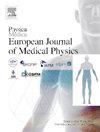A systematic review of the dosimetric consequences of the interplay effect
IF 3.3
3区 医学
Q1 RADIOLOGY, NUCLEAR MEDICINE & MEDICAL IMAGING
Physica Medica-European Journal of Medical Physics
Pub Date : 2025-05-20
DOI:10.1016/j.ejmp.2025.105004
引用次数: 0
Abstract
Purpose
The presence of intrafraction motion introduces challenges to thoracic irradiation. The objective of this review is to evaluate the impact of intra-fraction motion on target dose in lung cancer (interplay effect).
Method
A comprehensive search was conducted in 2024 across three databases using predefined keywords related to the interplay effect in conjunction with lung cancer. Inclusion criteria encompassed studies involving all external beam radiotherapy modalities, conducted from 2013 onwards. The Preferred Reporting Items for Systematic Reviews and Meta-Analyses guidelines were followed.
Results
Forty-three journal articles were identified meeting the criteria for inclusion in this analysis. The impact of the interplay effect was found to cause discrepancies in the delivered dose distribution to the target structure and organs at risk. The interplay dose discrepancies were quantified using simulation-based and measurement-based approaches in phantoms and retrospectively in patients. Further analysis revealed associations between interplay dose deviation and various breathing features, and beam delivery features. These findings underscore the multifactorial nature of interplay dose deviation, highlighting the need for comprehensive evaluation and consideration of various patient-specific and treatment-related factors in treatment planning and delivery.
Discussion
This systematic review emphasises the significance of personalised assessment and treatment optimisation strategies. Acquiring parameters during clinical trials for secondary analysis can allow technical features to be correlated with patient outcomes, enhancing our understanding of interplay dose error. Developing sophisticated simulation-based tools that incorporate all patient and machine-related factors will ensure dosimetric accuracy and improve patient outcomes.
对相互作用效应的剂量学后果的系统回顾
目的:屈光内运动的存在给胸部放射治疗带来了挑战。本综述的目的是评估肺癌中分数内运动对靶剂量的影响(相互作用效应)。方法使用与肺癌相互作用相关的预定义关键词,于2024年在三个数据库中进行了全面搜索。纳入标准包括2013年以来开展的所有外部放射治疗方式的研究。遵循系统评价和荟萃分析指南的首选报告项目。结果43篇期刊文章符合纳入分析的标准。发现相互作用效应的影响会导致靶结构和危险器官的剂量分布差异。使用基于模拟和基于测量的方法在幻影和回顾性患者中量化相互作用剂量差异。进一步的分析揭示了相互作用剂量偏差与各种呼吸特征和光束传递特征之间的联系。这些发现强调了相互作用剂量偏差的多因素性质,强调了在治疗计划和交付中需要综合评估和考虑各种患者特异性和治疗相关因素。本系统综述强调了个性化评估和治疗优化策略的重要性。在临床试验中获取用于二次分析的参数可以使技术特征与患者结果相关联,增强我们对相互作用剂量误差的理解。开发包含所有患者和机器相关因素的复杂模拟工具将确保剂量测定的准确性并改善患者的预后。
本文章由计算机程序翻译,如有差异,请以英文原文为准。
求助全文
约1分钟内获得全文
求助全文
来源期刊
CiteScore
6.80
自引率
14.70%
发文量
493
审稿时长
78 days
期刊介绍:
Physica Medica, European Journal of Medical Physics, publishing with Elsevier from 2007, provides an international forum for research and reviews on the following main topics:
Medical Imaging
Radiation Therapy
Radiation Protection
Measuring Systems and Signal Processing
Education and training in Medical Physics
Professional issues in Medical Physics.

 求助内容:
求助内容: 应助结果提醒方式:
应助结果提醒方式:


